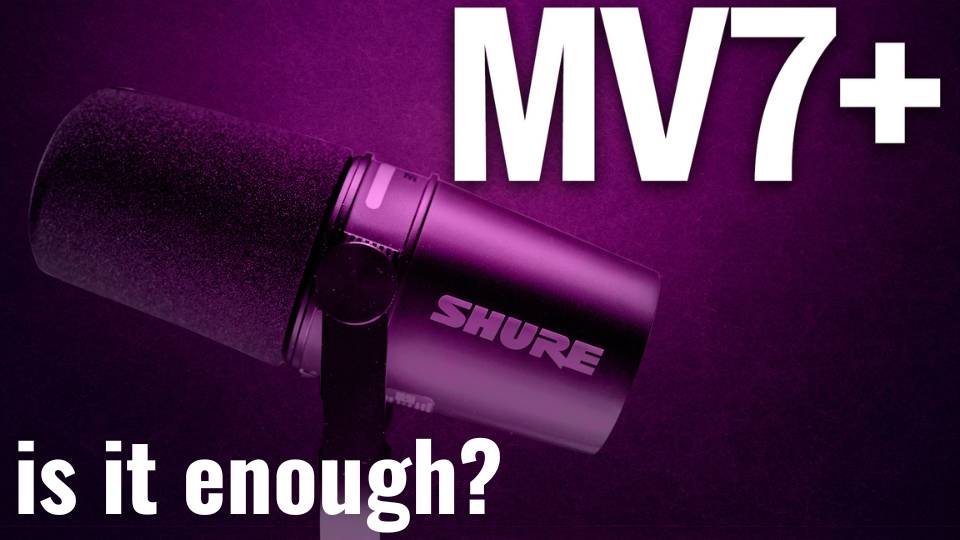Links in this post may be affiliate links. Any products purchased through affiliate links may provide a small commission which helps to support the SemiPro Tech+Gear site and YouTube channel.
The Shure MV7 was a game-changer upon its release in 2020, bringing better sound quality and versatility to home podcasters and remote workers for a more attainable price than professional gear. Fast forward to 2024, and we have the Shure MV7 Plus, an upgrade that promises to address the predecessor’s shortcomings while introducing new features. Whether you’re a seasoned broadcaster or starting your content creation journey, join us as we reivew the Shure MV7 Plus to see if it lives up to the standard of the original and the current marketplace.
Shure MV7 Plus
MSRP: $279 USD
Pros
- Enhanced plosive protection with modified windscreen design
- Improved real-time audio processing features including denoise and popper stopper
- Dual output capabilities with USB-C and XLR connections
- Retention of DSP settings in the microphone for versatile use across devices
- Straightforward and user-friendly
Cons
- Removal of physical controls for gain and headphone volume
- Shock rejection is average, an aspect that could be improved given the microphone’s price range
- Desktop app is still in beta at the time of writing and not fully baked
- USB & XLR outputs sound a bit different (even with DSP turned off)
- USB-C output is great, but no USB-C to USB-A adapter included
Best For: Creators looking for a premium USB microphone with quality DSP features and don’t mind paying for it.
Features and Specifications
The MV7 Plus retains much of the respected core technology of the original MV7, including the dynamic mic capsule and the general body shape, but introduces several upgrades that enhance usability and performance. The transition from a micro USB port to a USB-C interface is an improvement (3 meter USB-C to USB-C cable included). The adjusted windscreen design now features an air gap between the windscreen and microphone capsule, improving plosive protection—addressing one of the biggest drawbacks to the original MV7.
Shure has overhauled the physical interface by replacing the original MV7’s controls with a touch-sensitive light bar that acts as a capacitive mute button and offers color customization through the software. There are no longer controls for microphone gain or headphone volume, but the mute button works well and doesn’t make any audible sound. The XLR and USB outputs can still be used simultaneously, although there is a bit of a different sound profile from the XLR output even with all the DSP turned off on the USB output – more of a difference than the original MV7.
In terms of the DSP over the USB connection, settings are still retained within the microphone. This is great for remote workers who use a company-provided computer that does not allow installing software. You can set up the DSP using your personal computer or smartphone, then plug the MV7 Plus into your work computer and all settings are retained. Several features carry over from the original, including auto-gain (though improved according to Shure), a limiter to prevent clipping, compressor, and high pass filter.
There are a few changes and additions, however, including a new tone shaping slider that goes from “Dark” on one extreme, to “Natural” in the center, and “Bright” on the other extreme. The “Dark” setting cuts back the higher frequencies, and helps to reduce sibilance as well. You can move between these in small increments, which is nice (30% Dark was my preferred setting). You can also do this independently from the high pass filter, which has 75Hz and 150Hz options. The big new DSP feature is the real-time Denoiser, which cuts out background noise in real-time as the name suggests. This is not a noise gate, but noise reduction/suppression. In my testing it worked very well for quieter noise sources like a computer fan in the room, without having too much of an impact on the audio quality. With louder noise it still works, but begins to leave that artifact-ridden “digital” sound – probably still better than not having it, though. The amount of noise reduction being applied appears to adjust based on the level of the noise which is very clever – check out the embedded video for samples. The “Popper Stopper” is the other new DSP feature, which is supposed to further reduce plosives. In my testing it did make a small difference, but nothing miraculous.
As for the technical specs, the image below shows the comparison with the original MV7. There’s nothing here too significant that is worthy of calling out.

Software
The new Shure Motiv Mix desktop app is how you adjust the DSP settings on a desktop computer (the older Shure Motiv desktop app does not support the MV7 Plus at the time of writing). It does not appear to support the original MV7 either – perhaps that will come later (or perhaps not). The Motiv Mix app is still in beta, and it shows. There are some promising features, like the ability to use non-Shure audio input sources to record, but it’s far from a polished audio application like Elgato’s Wave Mix software.
Aside from changing your MV7 Plus’s DSP settings, you can record one or multiple input sources locally, either as a mono mix or all channels separately. You can also configure your outputs separately. Strangely, at the time of writing you cannot control the recording settings. You can see them, but not change them – recordings are saved as WAV format, recorded in 32-bit float at 48kHz, similar to the default recording settings of Audacity.
For mobile devices, the existing Shure Motiv app was updated to support the MV7 Plus and worked fine for me on an iPhone 15 Pro Max.
MV7 Plus Final Thoughts
In a vacuum, save for a couple minor gripes the MV7 Plus looks like a solid evolution of what was already a great microphone for content creators and remote workers. In the past the MV7 has been called “the podcasting mic” that you should just buy and not think too hard about. While that type of advice is almost never 100% accurate, back in 2020 and 2021 when the original MV7 came out, it wasn’t that far off. At the time, there were not many competitors with a combination USB/XLR microphone that had DSP features and actually sounded good enough for that “pro” sound we all strive for. There were always XLR microphones that sound objectively better like Shure’s own SM7B, but spending $400 on a microphone that also requires an audio interface to produce your first podcast or call into work Zoom meetings was, and still is, unnecessary.
But the thing is, it’s not 2020 anymore. In 2024, there are a lot more competing products from reputable companies like the Rode PodMic USB, which offers very similar features and excellent sound quality at a lower price ($199). There are also much more affordable USB/XLR microphones from newcomers like Fifine and Maono, which may not offer all the same features, but they have come a long way in terms of sound quality in the last two years and offer options like the Fifine AM8 for around $50. Audio samples of the mentioned microphones are in the embedded video. There’s also the matter of whether you do plan to utilize the XLR output at some point. If you don’t, there are other USB-only microphones to consider (the same applies if you only plan on using the XLR output).
The MV7 Plus is still positioned as a “premium” option in the market at $279, but with much more competition at lower price points than four years ago. So while I would still recommend the MV7 Plus for podcasting, content creation, or remote work, in my opinion it’s no longer the microphone to get. In the space of USB/XLR microphones for content creation, there very well could be another option at a lower price point that provides everything you need and great sound quality, and that’s the difference between 2020 and 2024.
For a full rundown of all my recommended podcast microphones at different price points, check out this article.




